The Manaslu region is one of Nepal’s most spectacular trekking areas, combining remote Himalayan landscapes, Tibetan-influenced culture, and close-up views of the eighth-highest peak in the world.
While trekking is possible year-round, the best time to visit is during Spring (March to May) and Autumn (September to November). Each season, however, offers a distinct experience that shapes your journey.
Treks such as the Manaslu Circuit Trek, the Manaslu Tsum Valley Trek, and the Short Manaslu Trek take you through ancient monasteries, traditional stone villages, and some of the most breathtaking alpine scenery in Nepal.
Seasonal Comparison for Trekking in Manaslu Region
For a quick overview, here is a comparative outline of trekking in the Manaslu region across different seasons.
| Season | Months | Weather | Trail Condition | Pros | Cons | Suitability |
|---|---|---|---|---|---|---|
| Spring | March – May | Mild days, cool nights, rhododendrons bloom | Dry, stable, colorful | Comfortable trekking, vibrant forests, lively villages | Busy in April at teahouses | Excellent for most trekkers |
| Summer / Monsoon | June – August | Hot, humid, heavy rain, cloudy skies | Muddy, leeches, landslide risk | Lush greenery, waterfalls, very quiet | Poor visibility, slippery trails | Not recommended |
| Autumn | Sept – Nov | Clear skies, moderate temps, stable weather | Best trail conditions | Sharp mountain views, festival season, reliable weather | Crowded lodges, high demand | Best choice for most trekkers |
| Winter | Dec – Feb | Cold, snow above 3,500m, icy winds | Snow-covered trails, some closures | Quiet paths, dramatic snow scenery | Harsh cold, passes may be blocked | Suitable only for experienced trekkers |
Recommended Seasons for Manaslu Trek
Spring (March to May)
Spring brings vibrant colors and renewed life to the Manaslu region, with rhododendrons in bloom, lively monasteries, and longer days perfect for trekking.
Weather
- Mild, stable conditions from Soti Khola through Namrung and Lho.
- Nights are chilly in Samagaon and Samdo, though manageable.
- Pre-monsoon showers may arrive in May.
Views
- Rhododendrons bloom around Namrung and the Nubri Valley.
- Crystal-clear skies frame Manaslu, Himal Chuli, and Ganesh Himal.
- Birendra Lake and Manaslu Base Camp glow in spring light.
Trail Conditions
- Trails are dry and firm, with minimal landslide risk.
- Larkya La Pass (5,106m) becomes safer to cross late in spring as snow recedes.
- Side trips to Pungyen Gompa and Tsum Valley monasteries are rewarding.
Popularity
- Moderate crowds, quieter than autumn.
- Ideal season for the Manaslu Tsum Valley Trek, when monasteries like Rachen Gompa and Mu Gompa are at their liveliest.
Spring offers vibrant landscapes, cultural depth, and excellent trekking conditions with fewer crowds.
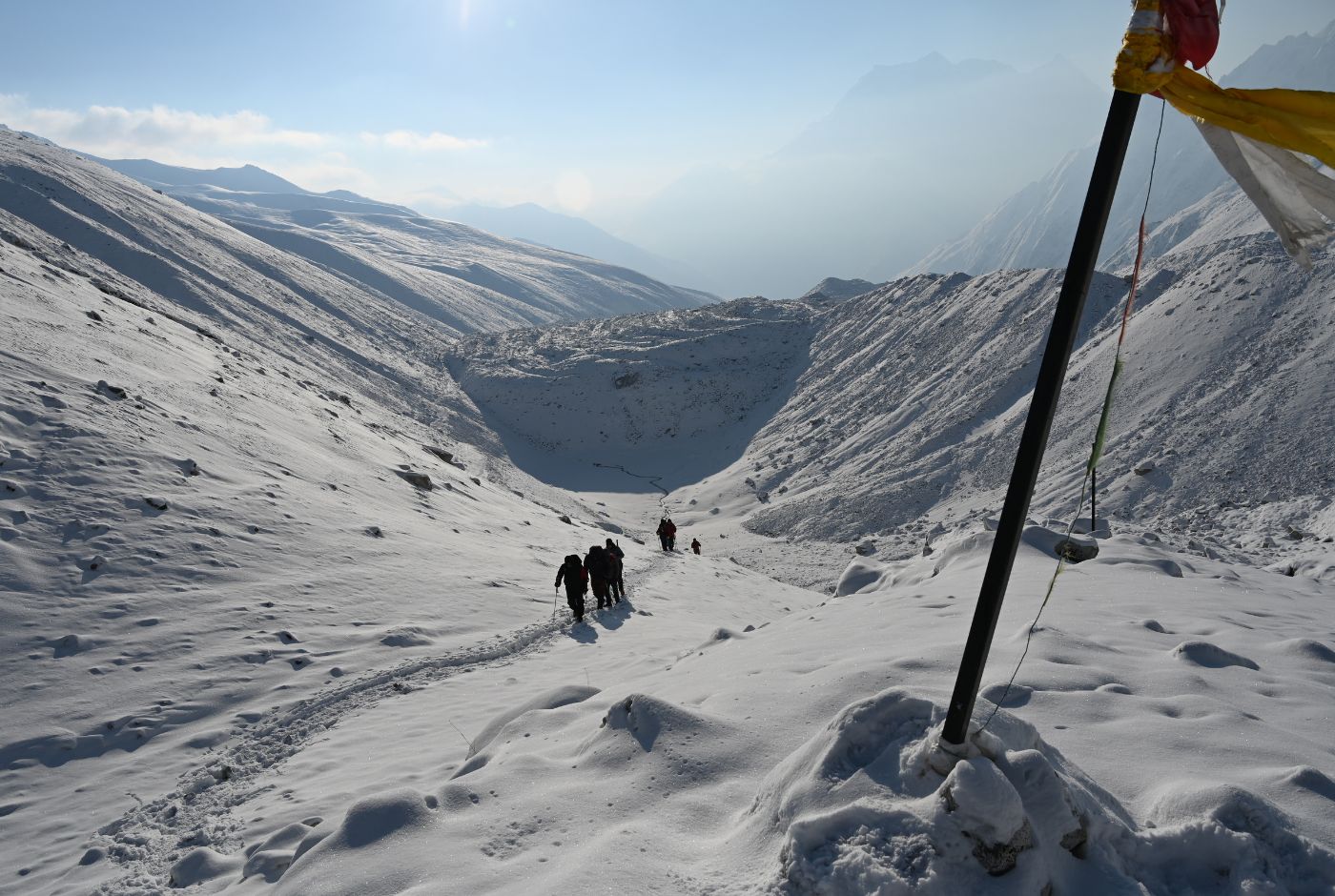
Autumn (September to November)
Autumn is the most popular trekking season in Manaslu, offering crystal skies, crisp air, and safe conditions for high-altitude routes.
Weather
- Stable and dry across all elevations.
- Pleasant days in Philim, Namrung, and Lho; freezing nights in Samagaon and Samdo.
Views
- Sharp panoramas of Mt. Manaslu (8,163m) from Lho and Shyala.
- Crossing Larkya La Pass reveals views of Himlung Himal, Cheo Himal, and Annapurna II.
- Birendra Lake reflects stunning autumn skies.
Trail Conditions
- Trails are dry and secure, perfect for long ascents.
- Larkya La crossings are most reliable in October.
- Tsum Valley trails are lush and easy to explore.
Popularity
- Peak trekking season; teahouses in Namrung, Samagaon, and Samdo fill quickly.
- The best time for the Manaslu Circuit Trek, with safe high-pass crossings and cultural richness.
Autumn is the ideal season for most trekkers, with unmatched clarity and the safest trail conditions.
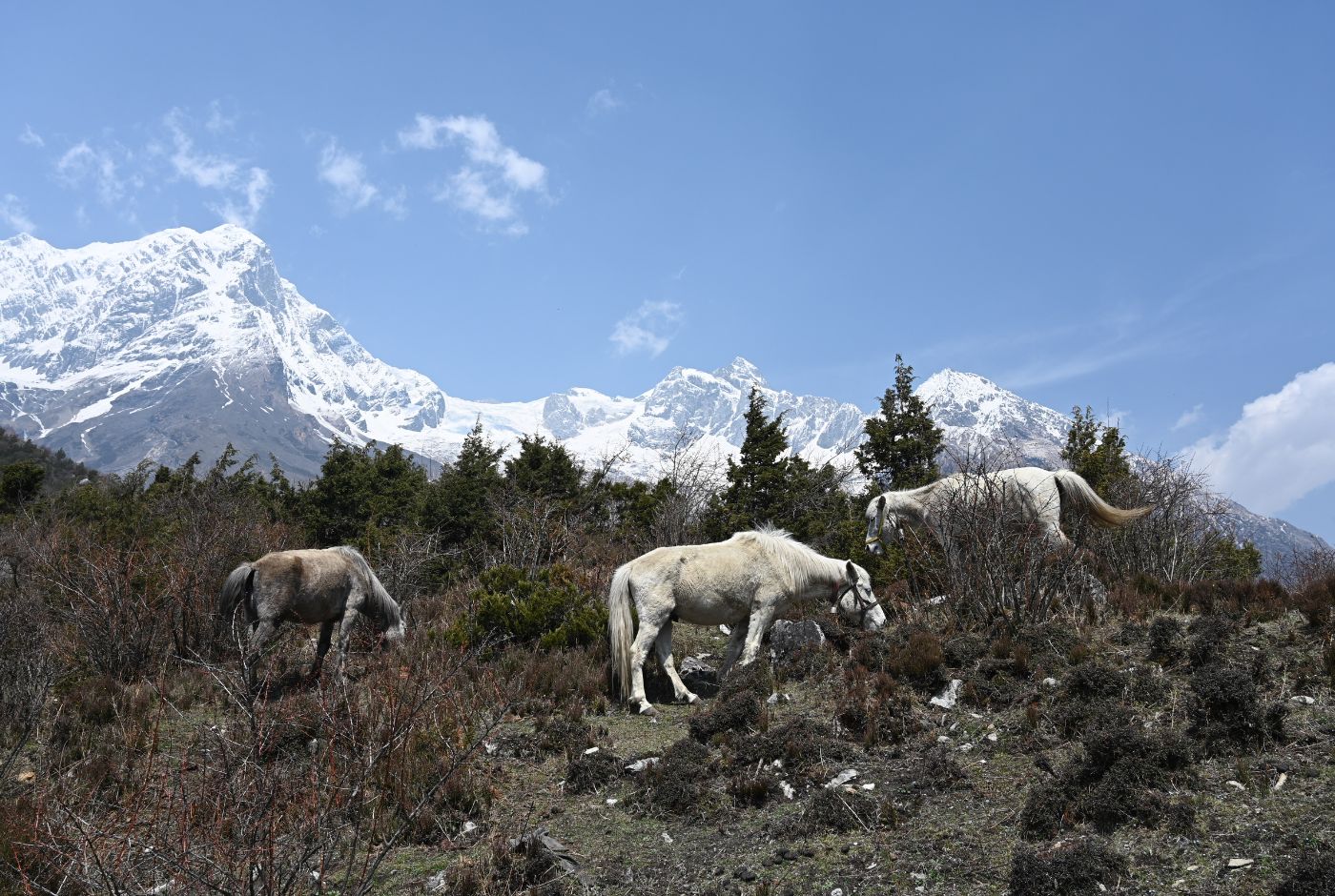
Not Recommended Season For Manaslu Trek
Monsoon (June to August)
The monsoon drenches the Budhi Gandaki valley, creating lush greenery but also dangerous and unstable conditions.
Weather
- Heavy rainfall in Jagat and Philim, with humidity and leeches common below 2,000m.
- Thick clouds often obscure views higher up.
Views
- Limited mountain visibility, though waterfalls and terraced fields are dramatic.
- Tsum Valley is misty and vibrant with summer growth.
Trail Conditions
- Slippery, landslide-prone paths, especially between Jagat and Deng.
- Rivers swell, crossings become hazardous.
- Larkya La Pass is unsafe in this season.
Popularity
Very few trekkers attempt the circuit during the Monsoon Season
Monsoon trekking is unsafe in Manaslu despite its lush landscapes and waterfalls.
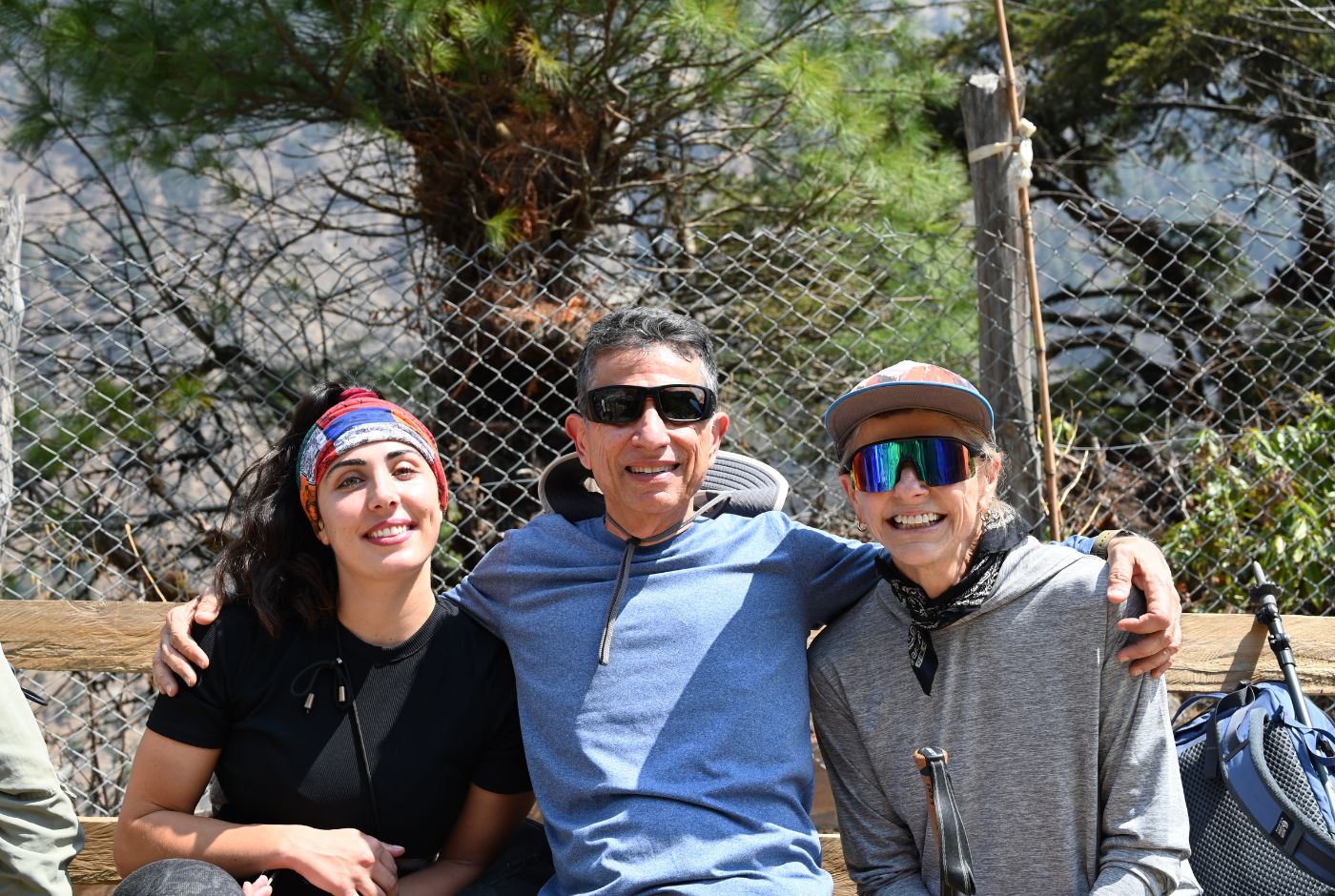
Winter (December to February)
Winter transforms Manaslu into a snowbound wonderland, with clear skies but harsh conditions at higher altitudes.
Weather
- Freezing above Samagaon and Samdo.
- Heavy snow closes routes to Manaslu Base Camp, Birendra Lake, and Larkya La.
- Lower villages like Namrung remain accessible.
Views
- Exceptionally sharp panoramas across the Nubri Valley.
- Tsum Valley offers serene and deeply spiritual winter landscapes.
Trail Conditions
- Trails above 4,000m blocked by snow and ice.
- Most teahouses in Samagaon and Samdo close.
- Lower cultural treks remain possible.
Popularity
- Very few trekkers; trails are quiet and serene.
- Best suited for the Short Manaslu Trek, exploring cultural highlights without venturing into high passes.
Winter offers solitude and breathtaking views but is not suitable for completing the Manaslu Circuit.
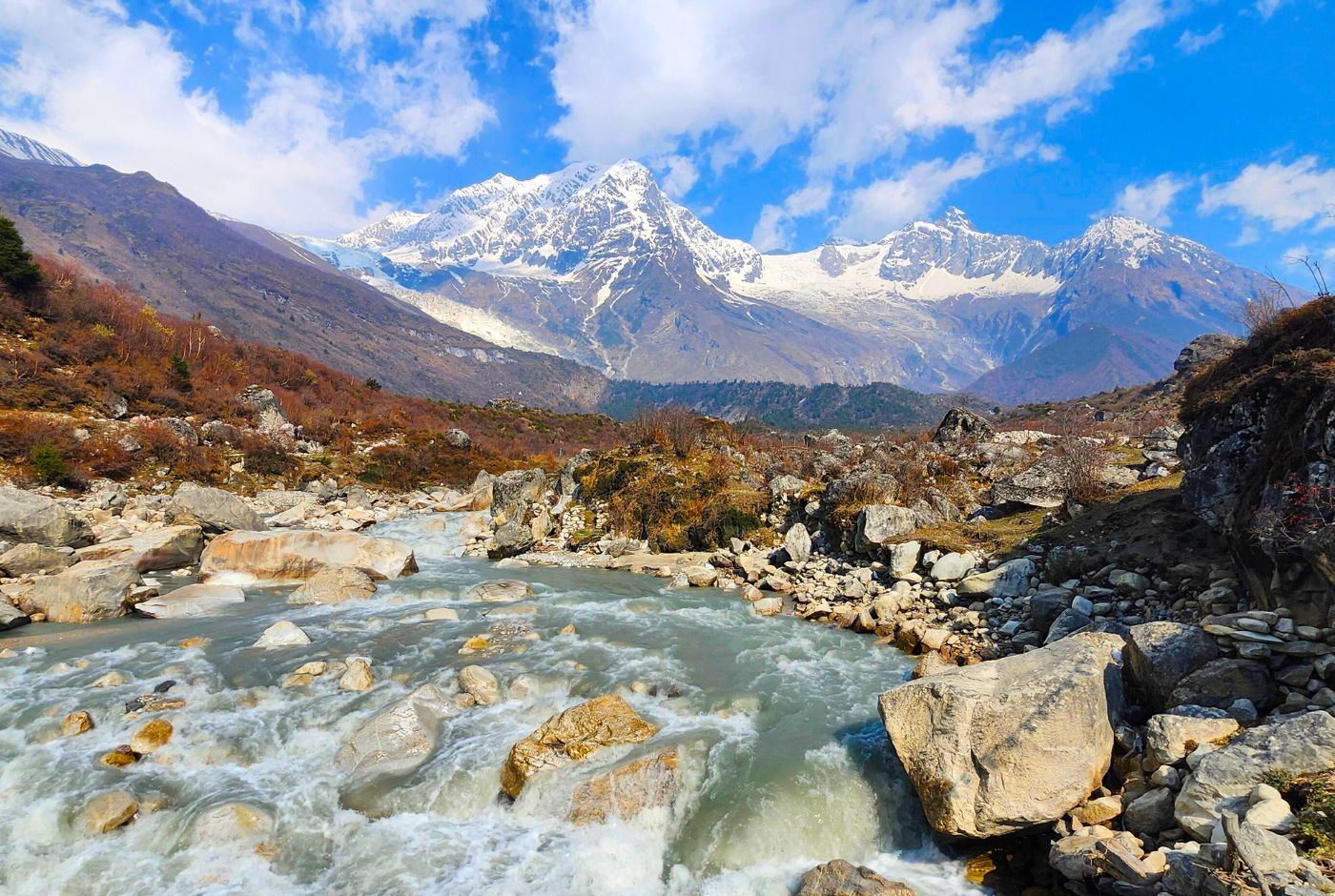
Highlights by Season
Spring (Mar–May): Rhododendrons in Namrung, side trips to Manaslu Base Camp and Birendra Lake, monasteries in Tsum Valley
Autumn (Sep–Nov): Crossing Larkya La Pass, sunrise at Lho, reflections at Birendra Lake, sweeping views from Nubri Valley.
Monsoon (Jun–Aug): Waterfalls in the Budhi Gandaki gorge, lush green terraces in Philim and Jagat.
Winter (Dec–Feb): Cultural exploration in Namrung and Philim, snowbound panoramas near Samagaon.Temperature Comparision:
Temperature Variation in Manaslu Region
| Month | Lower Altitude (Arughat, Soti Khola, Jagat) | Moderate Altitude (Philim, Larkya La Pass, Bimthang) | Higher Altitude (Samagaon, Manaslu Base Camp, Samdo) | |||
|---|---|---|---|---|---|---|
| Max (°C) | Min (°C) | Max (°C) | Min (°C) | Max (°C) | Min (°C) | |
| January | 2°C | -17°C | 8°C | -12°C | 16°C | -10°C |
| February | 3°C | -15°C | 8°C | -12°C | 17°C | -9°C |
| March | 8°C | -12°C | 11°C | -4°C | 16°C | -5°C |
| April | 11°C | -0°C | 16°C | -4°C | 17°C | -2°C |
| May | 16°C | -4°C | 17°C | 1°C | 17°C | 5°C |
| June | 17°C | 1°C | 17°C | 7°C | 16°C | 8°C |
| July | 17°C | 7°C | 17°C | 8°C | 17°C | 11°C |
| August | 17°C | 8°C | 17°C | 9°C | 16°C | 11°C |
| September | 15°C | 9°C | 15°C | 9°C | 15°C | 10°C |
| October | 31°C | -4°C | 16°C | -4°C | 16°C | 12°C |
| November | 9°C | -3°C | 11°C | -3°C | 9°C | 5°C |
| December | 4°C | -13°C | 5°C | -13°C | 4°C | -2°C |
Key Factors to Consider When Choosing Your Trekking Season
You must consider these key factors when choosing the season for Manaslu Trekking:
1. Match Your Goals with the Season
Spring (March–May): Best for colorful rhododendron blooms, stable weather, and clear mornings.
Autumn (September–November): Ideal for crystal-clear mountain views, pleasant temperatures, and vibrant festivals like Dashain and Tihar.
Winter (December–February): Quieter trails, crisp skies, but biting cold at higher altitudes—great for solitude seekers.
Monsoon (June–August): Lush greenery, fewer crowds, but heavy rains and leeches on low trails; perfect for rain-shadow treks
2. Think About Altitude
High passes are best in spring and autumn when snow risks are lower. In winter, these can be dangerous or even closed. Lower-elevation treks remain possible year-round with the right gear.
3. Factor in Trail Traffic
Autumn draws the largest crowds—teahouses may fill quickly, and trails can feel busy. Spring offers a balance: lively yet not overwhelming. Winter and monsoon bring peace, but fewer services remain open.
4. Consider Health and Safety
Colder months mean more risk of altitude-related illnesses due to slower acclimatization. Monsoon brings slippery trails and flight delays. Spring and autumn give the most reliable trekking conditions, with manageable risks.
5. Build Flexibility Into Your Plans
Even the best season has unpredictable days. Keep one or two buffer days for weather-related delays, especially if your trek involves high passes.
PRO INSIGHT: For first-time trekkers aiming for Manaslu Region, autumn and spring are unbeatable for safety, beauty, and overall experience. If you’re chasing quiet trails or cultural immersion, winter and monsoon open doors to unique adventures.
Why Choose Escape Himalaya for Your Manaslu Trek
Escape Himalaya has specialized expertise in the Manaslu region, ensuring safety, cultural immersion, and comfort throughout your journey.
Our licensed guides, many of whom are from Manaslu itself, combine technical skill with local insight, keeping you safe on challenging sections like Larkya La Pass while introducing you to the cultural heart of villages such as Namrung, Lho, and Samagaon. During peak season, when teahouses in Samagaon and Samdo fill quickly, we guarantee lodge reservations so you always have a warm place to rest.
Every trek is carefully tailored, whether you choose the classic Manaslu Circuit, the Tsum Valley extension, or the Short Manaslu Trek, to match your fitness, time, and interests. Safety is always our priority, with proper gear, first-aid kits, and two nights of acclimatization built into Lho and Samagaon. We also emphasize authentic cultural experiences, from monastery visits to local rituals, ensuring your journey supports and respects the communities you pass through.
With all-inclusive support that covers permits, transport, meals, and porter services, Escape Himalaya makes sure you focus on the trek itself, not the hassles. With us, the Manaslu region is more than a trek; it is a meaningful journey through landscapes and traditions very few travelers truly experience.
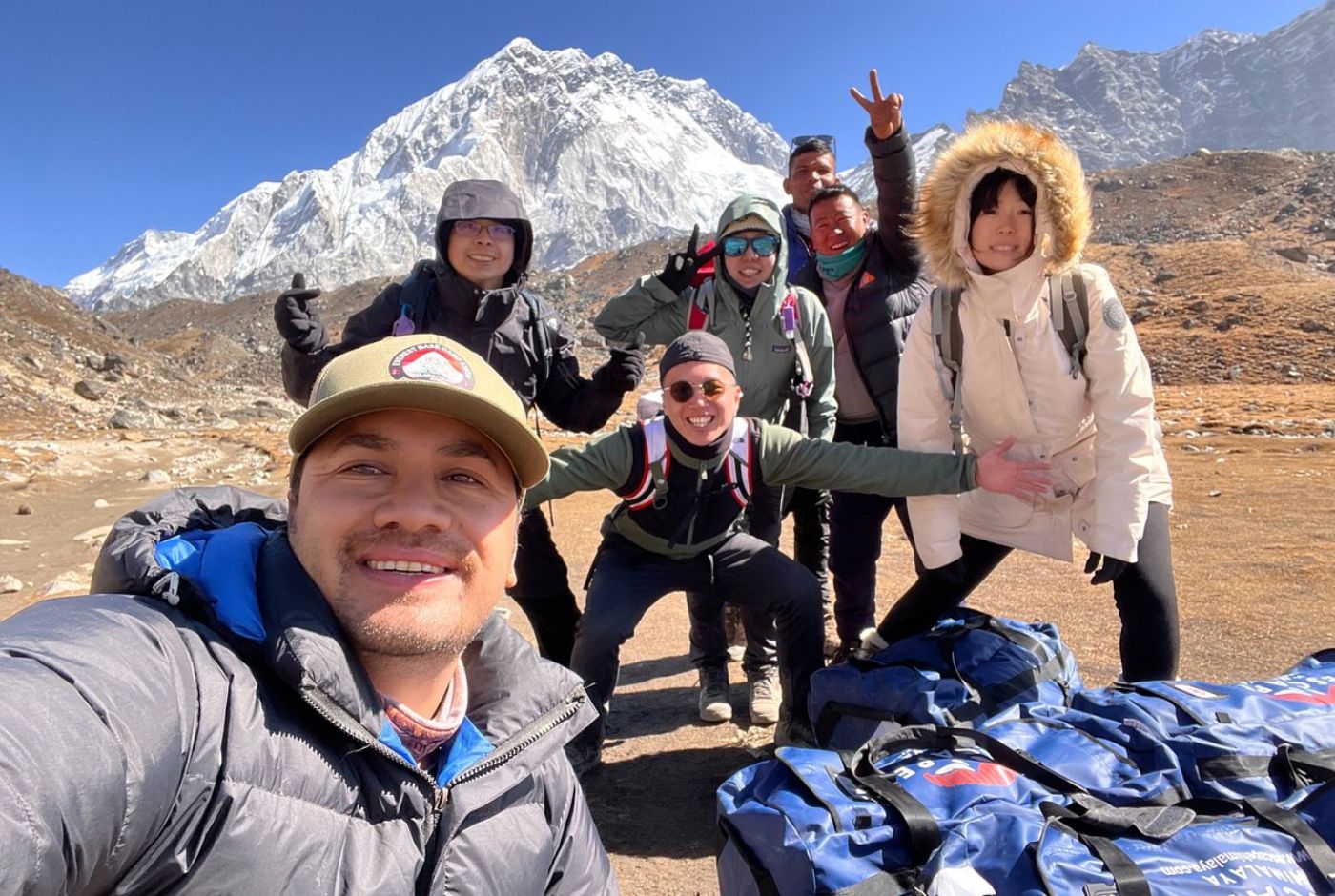
FAQs
We have compiled the most common questions about trekking seasons in the Manaslu region.
1. What month is best for the Manaslu Circuit Trek?
October is considered the best time for the Manaslu Circuit because it offers the most reliable trekking conditions of the year. The monsoon rains have cleared, leaving behind crisp air, dust-free trails, and vibrant green valleys. The weather is stable, dry, and mild, making trekking both comfortable and safe, with daytime temperatures pleasant and nights manageable. Most importantly, October skies are consistently clear, providing some of the most spectacular and unobstructed views of Manaslu and the surrounding Himalayan peaks.
Cultural vibrancy adds another layer to the experience, as October coincides with Nepal’s biggest festivals, Dashain and Tihar, allowing trekkers to witness unique local traditions along the trail. Combined with longer daylight hours and fully open teahouses, October delivers the ideal balance of scenery, safety, and cultural immersion, making it the most popular and rewarding month to trek Manaslu.
2. Is April a good time to trek in Manaslu?
Yes. Namrung, Lho, and Samagaon are surrounded by rhododendrons, and side trips to Manaslu Base Camp and Birendra Lake are excellent.
April is one of the best times for the Manaslu Circuit, with stable weather, clear skies, long daylight hours, and blooming rhododendrons creating colorful, scenic trails. The season offers excellent mountain views and comfortable conditions, though higher altitudes remain cold with possible snow.
Pros: Clear views, vibrant spring flora, mild weather, and extended trekking hours.
Cons: Cold temperatures at high passes, crowded trails, and occasional unpredictable weather.
3. Can I trek Manaslu in December?
Yes, you can trek Manaslu in December, but it’s a challenging winter adventure. Early December is more feasible with manageable conditions, while late December brings harsher cold, heavy snow, and potential trail closures. The rewards include fewer crowds, lower costs, and stunningly clear mountain views in a serene winter setting.
Pros: Quiet trails, crystal-clear views, budget-friendly prices, and a unique snow-covered Himalayan experience.
Cons: Extreme cold, possible Larke La Pass closure, difficult snow-covered trails, and limited teahouses.
Tips: Go early in the month, hire a guide, pack proper winter gear, and allow flexibility for delays. Best suited for adventurous, experienced trekkers.
4. What is the weather like in October in Manaslu?
In October, the Manaslu region experiences average daytime temperatures ranging from 13°C to 25°C. At higher elevations below 4,000m, daytime temperatures usually remain around 15–16°C, while nights can drop to -1°C. Above 4,000m, conditions become colder, with nighttime temperatures often falling to -2°C during the Manaslu Circuit Trek.
Dry, sunny days and crisp nights. Comfortable in Namrung, colder in Samagaon, with perfect visibility for mountains.
5. Is trekking in the monsoon possible in Manaslu?
Trekking in the Manaslu region during the monsoon is generally discouraged due to hazards like landslides, swollen rivers, slippery trails, leeches, and poor visibility. The heavy rainfall obscures mountain views, creates discomfort from humidity, and limits available teahouse services.
Main Challenges includes
- Muddy, unstable trails prone to landslides
- Blocked mountain views from clouds and fog
- Leeches and insects in humid, forested zones
- Dangerous river crossings due to flooding
- Discomfort from wet gear and high humidity
- Limited accommodation options
If Attempted
- Best suited for highly experienced trekkers with monsoon trekking background
- Essential to carry waterproof gear, insect repellent, and trekking poles
- Flexibility in itinerary is crucial due to unpredictable conditions
6. Which season does Escape Himalaya recommend for first-time trekkers?
We, Escape Himalaya recommend Spring (March–May) and Autumn (September–November) as the best seasons for first-time trekkers in Nepal. Spring brings warm, pleasant weather, clear blue skies, and trails lined with blooming rhododendrons, creating a vibrant atmosphere. Dry, gentle paths make trekking more comfortable, reducing the risk of altitude sickness, while cultural festivals like Holi add richness to the journey.
Autumn, following the monsoon, offers crisp air, crystal-clear mountain views, and stable, dry weather which is perfect for trekking. The landscapes are lush and colorful, with valleys transitioning into golden hues, and major festivals such as Dashain and Tihar provide a deeper cultural experience. Both seasons combine favorable conditions, striking scenery, and cultural vibrancy, making them ideal for beginners in Nepal.
Concluding Notes from Escape Himalya
The best time to trek in the Manaslu region is during spring (March to May) and autumn (September to November). Spring highlights rhododendron forests, monastery life in Tsum Valley, and warmer days, while autumn delivers crystal skies, safe high passes, and unmatched Himalayan panoramas.
For cultural immersion, alpine adventure, or short getaways, Escape Himalaya offers three carefully designed options: the Manaslu Circuit Trek, the Manaslu Tsum Valley Trek – 20 Days, and the Short Manaslu Trek. Choosing the right season ensures not just a trek, but an unforgettable Himalayan journey. You can delve more on treks of Nepal here.
Want to lock in your trekking dates? Let’s chat.






